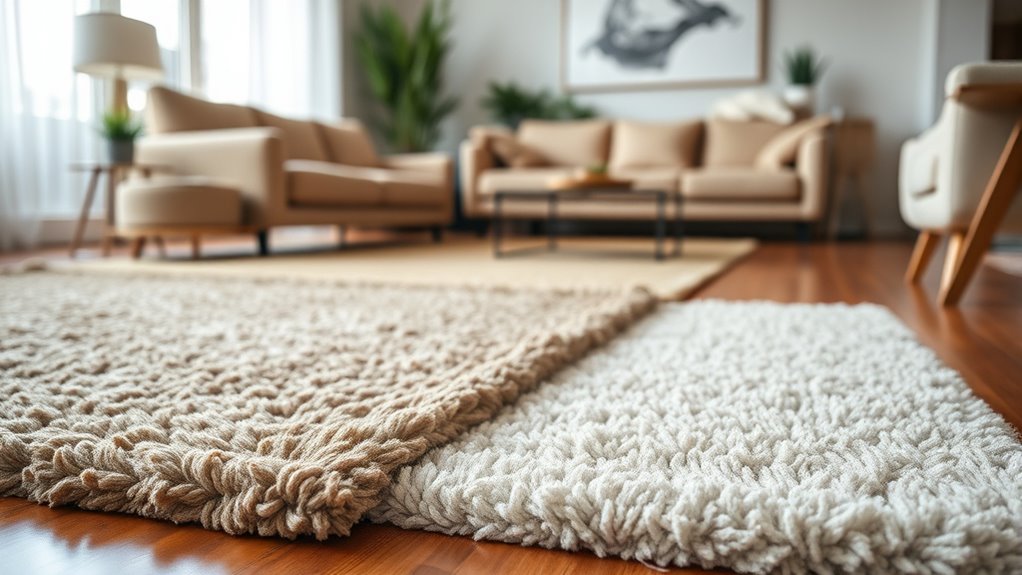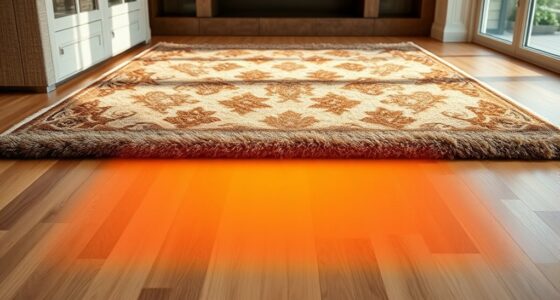Rugs help dampen sound by absorbing and scattering noise waves, especially thick, plush, and densely woven options. Scientific tests show that materials like wool and layered textures can markedly reduce echo and chatter, making your space quieter. Larger coverage and high-pile designs boost these effects further. If you want a clearer understanding of how different rugs improve room acoustics, you’ll discover effective tips and real-world examples that can transform your space further.
Key Takeaways
- Dense, plush rugs with high fiber density effectively absorb sound and reduce echo in various spaces.
- Thick, low-pile rugs scatter sound waves, enhancing acoustic dampening and minimizing noise transmission.
- Layered or multi-material rugs increase sound absorption through added textures and materials.
- Rugs covering larger areas improve overall noise reduction and create quieter environments.
- Combining rugs with other soundproofing solutions like acoustic panels amplifies sound dampening benefits.
Understanding Sound Absorption and Its Measurement

Understanding sound absorption begins with recognizing how materials reduce noise by converting sound energy into heat. When sound waves hit a surface, some are reflected, while others are absorbed. Sound absorption measures how effectively a material diminishes noise, which is essential for acoustic comfort. Acoustic measurement involves testing materials to determine their absorption coefficient, typically using devices like sound level meters and specialized chambers. These tests quantify how much sound energy is taken in by a material at different frequencies. Rugs play a critical role in this process because their fibers and textures help absorb sound waves, lowering overall noise levels. Additionally, the sound absorption coefficient varies across different rug materials and textures, influencing their effectiveness in noise reduction. Advancements in neural networks are also enhancing the precision of acoustic testing methods, leading to better material selection. Recognizing the regional variations in noise levels can further optimize the choice of sound-absorbing rugs for specific environments. Moreover, understanding material properties aids in selecting rugs that best contribute to acoustic comfort.
How Rugs Reduce Noise: The Science Behind It
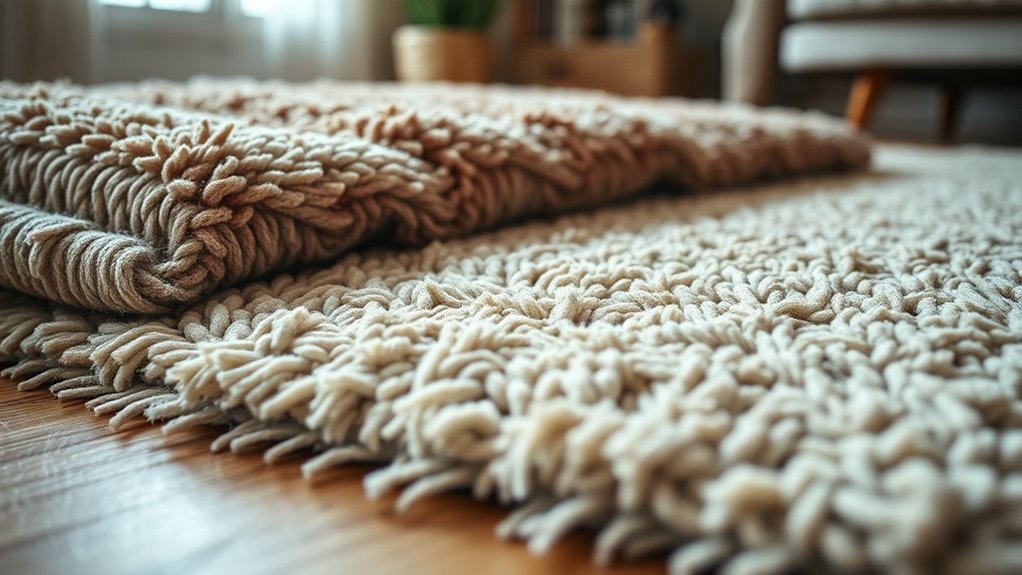
Rugs reduce noise by actively disrupting sound waves as they travel through a space. This process involves dampening techniques rooted in acoustic engineering principles. When sound waves hit a rug, the fibers and surface absorb and scatter energy, decreasing the intensity of echoes and reverberations. Unlike hard surfaces that reflect sound, rugs break up sound waves, preventing them from bouncing around. This absorption reduces overall noise levels, especially in rooms with high ceilings or hard flooring. The science behind it shows that thicker, plush rugs offer better sound dampening because they provide more material to absorb and diffuse sound energy. Additionally, the sound absorption properties of rugs enhance their effectiveness in quieting environments and creating a more peaceful atmosphere. The emotional support provided by a cozy environment can contribute to a more comfortable and peaceful living space. Incorporating rugs into your space also takes advantage of acoustic engineering principles to optimize sound control. By leveraging these fundamental concepts, you can effectively enhance comfort and reduce unwanted noise in your home. Furthermore, utilizing modern soundproofing techniques alongside rugs can further improve acoustic performance.
Materials and Textures That Maximize Acoustic Benefits
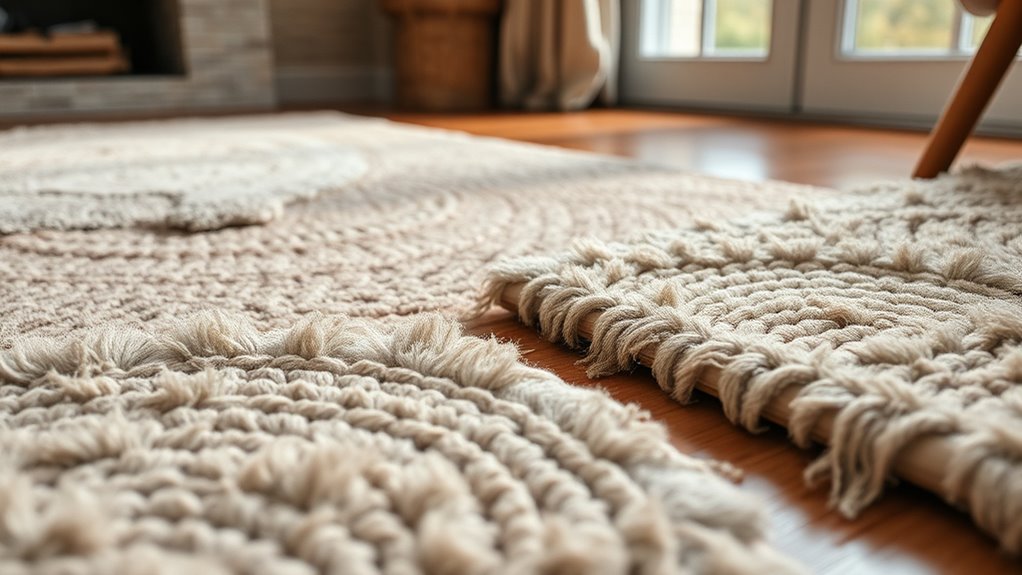
Choosing the right materials and textures can substantially boost your rug’s soundproofing. Thick, plush fabrics and dense, low-pile textures absorb more sound waves, reducing noise effectively. Natural, fibrous materials like wool also enhance acoustic benefits while adding durability and style. Incorporating sound absorption properties into your rug selection can further improve its effectiveness in dampening noise. Additionally, selecting materials with inherent soundproofing qualities can create a more peaceful environment by minimizing sound reflections and transmission. Using rugs with dense, low-pile textures can further optimize sound absorption, especially in spaces prone to echo or noise. Moreover, integrating advanced materials such as acoustic foams or specialized fibers can significantly enhance these effects.
Thick and Plush Fabrics
Thick and plush fabrics are among the most effective materials for absorbing sound, thanks to their dense textures and soft surfaces. These fabrics trap air within their fibers, reducing echo and noise transmission. When choosing rugs, consider fiber aesthetics—materials like wool or high-pile synthetics not only enhance visual appeal but also improve acoustic performance. Keep in mind that plush rugs require regular maintenance to preserve their sound-absorbing qualities; vacuuming gently and occasional deep cleaning prevent matting and dust buildup. The softness and density of plush fabrics make them ideal for creating a quieter, more comfortable environment. Additionally, selecting appropriate fiber materials can further enhance the acoustic benefits of your space. Using sound-absorbing textiles strategically in your decor can amplify these effects. Incorporating thick and plush fabrics into your interior design promotes soundproofing by significantly reducing noise levels. By choosing thick, plush textiles, you maximize both the aesthetic warmth and acoustic benefits of your space, making it more inviting and less echo-prone. Moreover, understanding acoustic data can help you select the best materials for your specific needs.
Dense, Low-Pile Textures
Dense, low-pile textures are highly effective at absorbing sound because their compact fibers minimize air gaps, reducing noise reflection and transmission. The high fiber density creates a solid barrier that muffles sound waves, making your space quieter. Texture variation within low-pile rugs also enhances absorption by disrupting sound flow. When choosing rugs, opt for dense, tightly woven options to maximize acoustic benefits. These textures work well in spaces where sound clarity and privacy matter most. Additionally, selecting sound-absorbing materials that complement rug textures can further improve overall acoustic performance. The density and material choice directly influence the acoustic properties of your space, ensuring optimal sound control. The fiber density of a rug plays a crucial role in sound absorption, helping to create a more serene environment. Below is an emotional depiction of different textures and fiber densities:
| Texture & Density | Acoustic Impact |
|---|---|
| Tight, low-pile | Deep silence, reduced echo |
| Dense, uniform fibers | Calm, peaceful environment |
| Minimal variation | Consistent noise control |
Natural, Fibrous Materials
Natural, fibrous materials like wool, jute, and sisal are excellent choices for sound absorption because their irregular structures and porous fibers trap air and dampen sound waves effectively. These materials provide a natural acoustic buffer, reducing echo and noise. Unlike synthetic fibers, they offer eco-friendly options with authentic textures. You can choose rugs with decorative patterns that highlight their natural fibers, enhancing your decor while improving acoustics. For ideal sound dampening, look for rugs with:
- Thick, dense fibers
- Looped or textured surfaces
- Layered or multi-material designs
- Natural color tones that complement the fibers
Enhanced acoustic properties can be achieved by selecting rugs that utilize these natural materials, leveraging their inherent ability to absorb sound effectively. Incorporating natural fibers into your decor not only improves sound quality but also promotes sustainability and eco-friendliness. Additionally, choosing materials with textured surfaces enhances the sound absorption capabilities by disrupting sound wave propagation within the space.
Comparing Rug Types: Which Are Most Effective for Sound Dampening
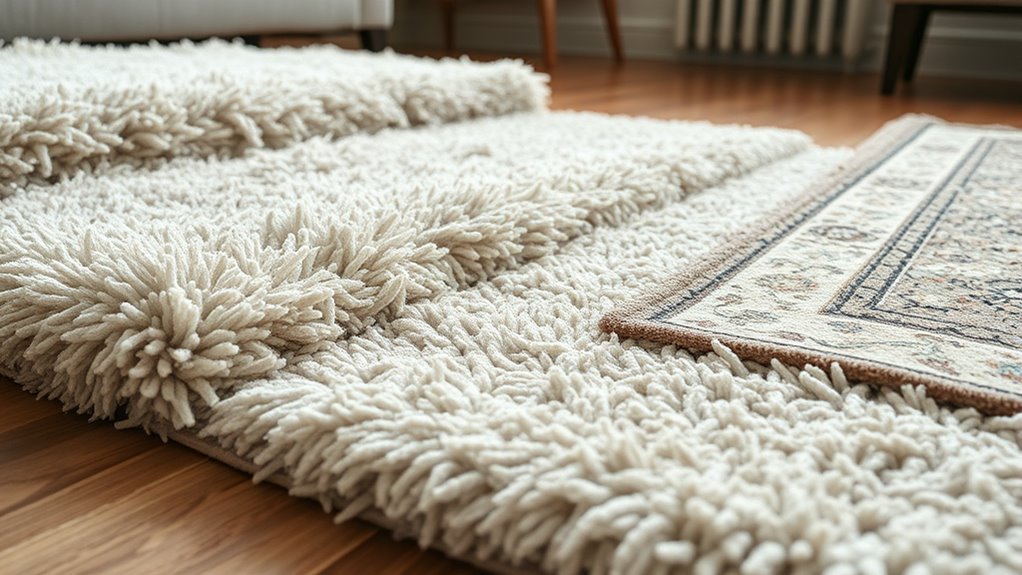
When choosing a rug for sound dampening, material density plays a key role—denser fabrics absorb sound better. Thickness and coverage also matter, with thicker rugs covering more area and providing increased noise reduction. Considering these factors helps you pick the most effective rug type for your space.
Material Density Impact
The effectiveness of a rug in dampening sound largely depends on its material density, as denser materials absorb and block noise more efficiently. Higher fiber density means more material packed into the rug, improving sound absorption. Material porosity also plays a role; less porous materials trap sound waves better. Rugs made from dense wool or felt typically outperform thinner synthetic options.
- Denser fibers increase sound absorption.
- Low porosity materials block sound transmission effectively.
- Thicker, tightly woven rugs enhance sound dampening.
- Material composition directly influences acoustic performance.
Thickness and Coverage
Thickness and coverage are crucial factors in determining a rug’s sound-dampening effectiveness. Thicker rugs with dense fiber weave absorb more sound waves, reducing echo and noise transmission. Larger coverage areas also enhance soundproofing, especially in spaces where noise control is a priority. Rugs with heavy, plush fibers tend to dampen sound better than thin, flat-weave options. Additionally, decorative patterns can influence coverage; layered or multi-textured designs often add extra thickness, boosting sound absorption. When selecting a rug, consider both its thickness and how much surface area it covers. Opt for high-pile or shag rugs for maximum dampening, and ensure they extend across key areas to effectively reduce sound reflections throughout the room.
Real-World Applications and Case Studies
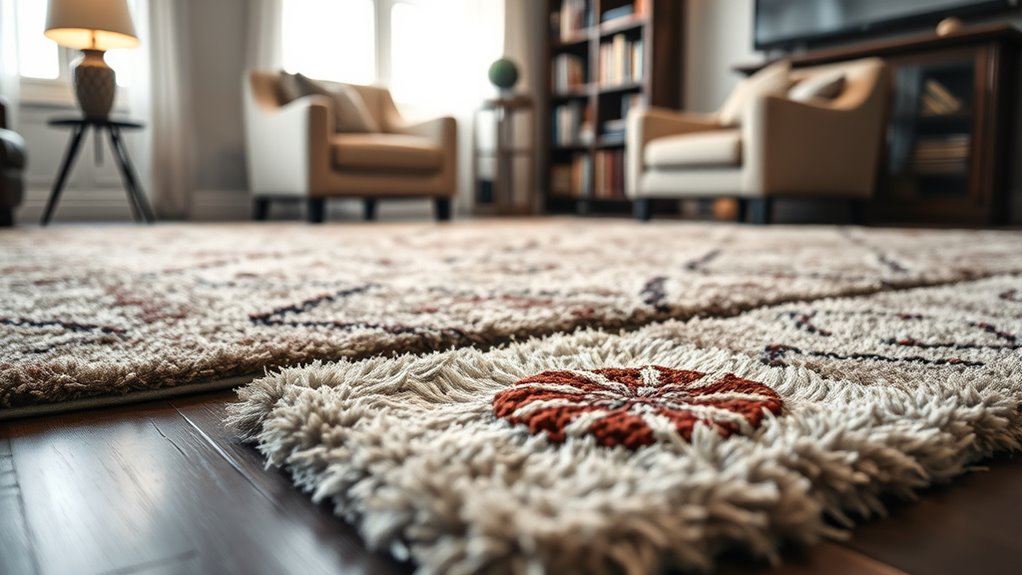
Rugs have proven highly effective in diverse real-world settings by substantially reducing noise levels and improving acoustic comfort. For example, in urban environments, they help buffer city noise, creating quieter indoor spaces. In offices, rugs enhance office acoustics by absorbing sound, reducing echo, and minimizing distractions. Case studies reveal that adding rugs to open-plan offices lowers ambient noise and boosts productivity. Similarly, in cafes and restaurants, rugs dampen footsteps and chatter, improving customer experience.
- Urban noise reduction in apartments
- Enhancing office acoustics in open workspaces
- Sound control in educational facilities
- Noise mitigation in healthcare settings
Tips for Choosing the Right Rug for Acoustic Improvement
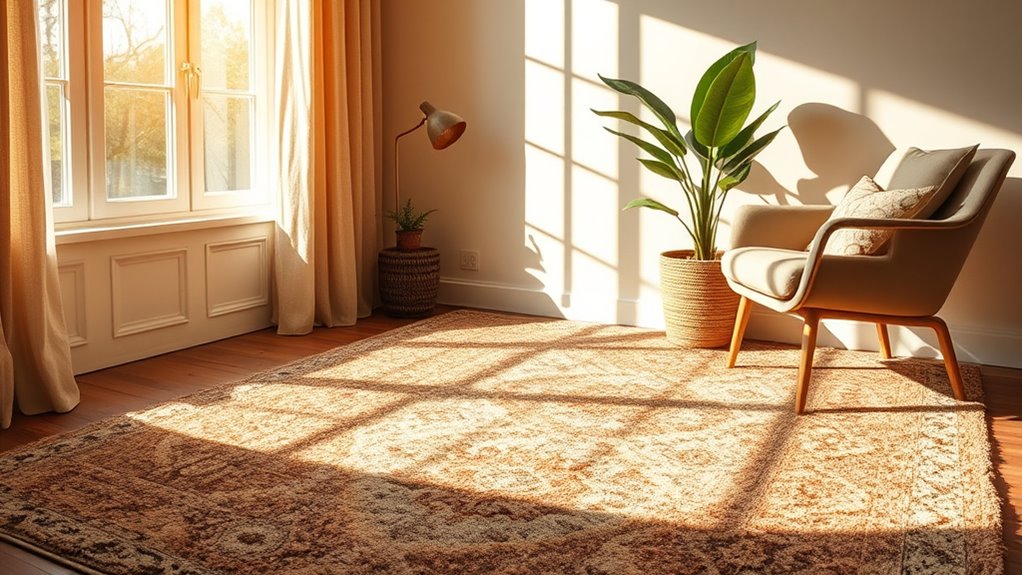
Choosing the right rug for acoustic improvement involves considering both material and placement to maximize sound absorption. Look for rugs with dense fibers or thicker textures, as they better dampen sound waves. When selecting a rug, consider decorative patterns that can help mask noise by disrupting sound reflections, making the space feel quieter. Color coordination also plays a role; neutral or darker shades tend to hide stains and wear while blending seamlessly with your room’s decor. Position the rug in high-traffic areas or directly under furniture to enhance sound absorption where it’s most needed. Ultimately, balancing style with function ensures your rug not only complements your decor but also effectively reduces noise levels, creating a more peaceful environment.
Combining Rugs With Other Soundproofing Methods
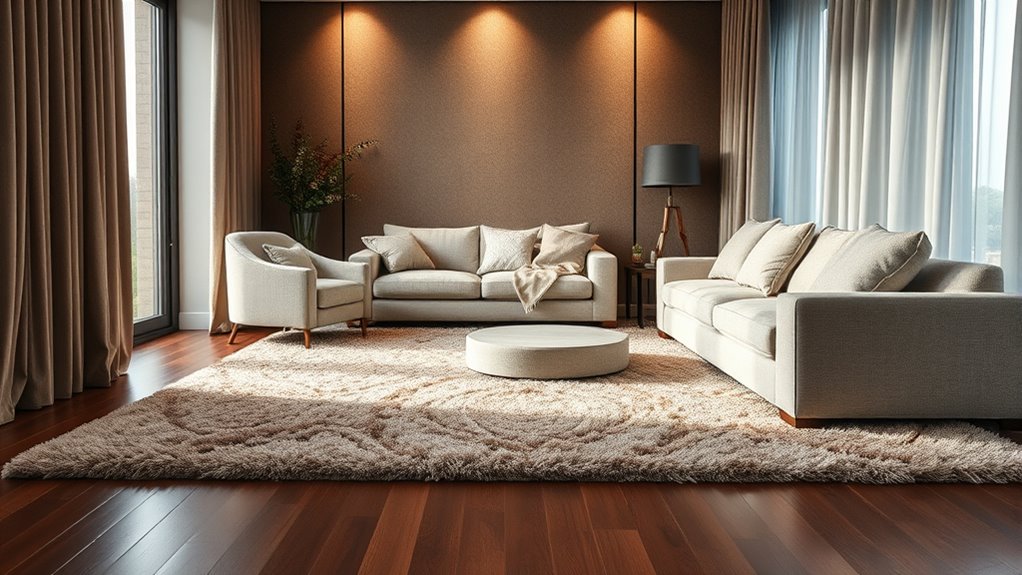
To achieve maximum soundproofing, it’s effective to combine rugs with other methods like acoustic panels, door seals, or window treatments. Incorporating decorative patterns in your rugs can enhance your space’s aesthetic while improving acoustics. Using color psychology, you can choose calming hues to create a peaceful environment or vibrant tones to energize the room. Pairing rugs with these soundproofing tools offers a layered approach to reduce noise effectively. Consider these options:
- Adding acoustic panels with complementary decorative patterns
- Installing door seals to block sound leaks
- Using window treatments that match your rug’s style and color
- Combining rugs with wall hangings for visual and acoustic harmony
This strategy maximizes both function and design, creating a serene, stylish space.
Frequently Asked Questions
How Does Rug Placement Impact Its Soundproofing Effectiveness?
Rug placement greatly impacts its soundproofing effectiveness. You should focus on ideal positioning by placing rugs in high-traffic or noisy areas, like under furniture or in front of doors, to absorb more sound. Spreading rugs across the room increases coverage, reducing echoes and noise. Proper placement ensures maximum sound dampening, making your space quieter and more comfortable. Positioning strategically helps you get the best acoustic benefits from your rugs.
Can Rugs Improve Sound Quality, Not Just Reduce Noise?
Imagine stepping into a room where every sound feels just right—your voice, music, and ambient noise blend seamlessly. Rugs can do more than cut noise; they improve sound quality by adding warmth and richness. Choose rugs with decorative patterns and durable materials, enhancing both aesthetics and acoustics. Their texture and design influence how sound waves bounce, creating a cozy, inviting space that feels balanced and harmonious.
Are There Specific Rug Shapes That Enhance Acoustic Performance?
You might wonder if certain rug shapes can improve acoustic enhancement. Generally, irregular or non-traditional shapes like asymmetrical or circular rugs help break up sound waves more effectively than standard rectangles. These shapes disperse sound energy, reducing echoes and enhancing clarity. So, choosing unique rug shapes can actively contribute to better acoustics in your space, making it more comfortable and sound-friendly.
How Maintenance Affects the Acoustic Properties of Sound-Absorbing Rugs?
Your sound-absorbing rug’s acoustic magic depends heavily on maintenance. If you neglect regular rug cleaning, dust and dirt can clog fibers, drastically reducing its sound-dampening power—like muffling a symphony to a whisper. Choosing durable materials ensures your rug stays effective longer, resisting wear and tear. Keep it clean and durable, and your rug will continue to absorb noise like a champion, transforming your space into a peaceful oasis.
What Are the Limitations of Using Rugs for Sound Dampening?
You might find rugs helpful for sound dampening, but they do have limitations. Material limitations mean some rugs aren’t dense enough to absorb all sound, especially for low frequencies. Aesthetic constraints can also restrict your choices, as certain designs or colors might not match your decor. Additionally, rugs alone won’t eliminate noise completely; they work best when combined with other soundproofing methods.
Conclusion
Just like a sponge soaks up water, the right rug can soak up sound and transform your space. By understanding how materials and textures work, you can pick the perfect rug to dampen noise effectively. Combining rugs with other soundproofing methods enhances your acoustic environment even more. So, don’t overlook the power of a simple rug — it’s your first line of defense in creating a quieter, more comfortable home.
